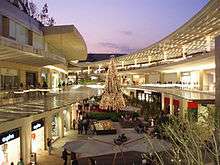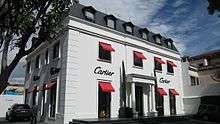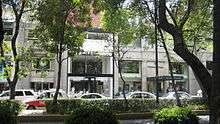Polanco, Mexico City

| Polanco | |
|---|---|
 Polanco Location of Polanco in Central/Western Mexico City | |
| Coordinates: 19°26′N 99°12′W / 19.433°N 99.200°W | |
| Website | http://www.polanco-online.com.mx |

Polanco is a famous and upscale district in Mexico City. The neighborhood is notable because of its cultural diversity and some of the wealthiest families in Mexico and Latin America have homes in Polanco, and a very long list of politicians, celebrities, artists and businessmen call the area home.
The neighborhood is also populated with expensive offices, restaurants, museums, luxurious stores and shopping malls; some embassies are also located in Polanco, including the embassy of Canada. [1] Its Avenida Presidente Masaryk is the highest-priced street and the one with the most upscale boutiques in Latin America. It is compared by some to Beverly Hills' Rodeo Drive or New York City's Fifth Avenue
The area is located in the Miguel Hidalgo borough of Mexico City, situated north of Chapultepec Park and consisting of five official neighborhoods ("colonias").
History
The colony takes its name from a river that crossed what is now the Avenue Champs Elysees, which in turn received it to honor the memory of the Spanish Jesuit Juan Alfonso de Polanco, who was secretary of Ignatius of Loyola and whose descendants of the Polanco family were members of the board of the Kings of Spain in the 18th century and came to Mexico as officers of the Crown.
In a plane made by Francisco Antonio Guerrero y Torres and dated 1784, a "ruined house Polanco" is located on the grounds of the Hacienda de San Juan de los Morales. This hacienda was part of the land donated in the sixteenth century to Hernán Cortés by the King of Spain, under the jurisdiction of Tacuba. At the beginning of the colonial times, parts of this land (near the current center of the Hacienda) were occupied for planting mulberry trees for breeding silkworms (hence the name "los morales"). The hull of the Treasury as currently known dates from the eighteenth century. Extensions lands belonging to the estate began to be divided in the late 1920s.
Polanco was developed in 1937 by the Aleman family, the same developers of Ciudad Satélite and San José Insurgentes districts, in the land that was originally the Hacienda de los Morales, just north of Molino del Rey town and Bosque de Chapultepec . The first area to be built was the one that is now called Polanco Reforma and lies just north of Paseo de la Reforma, the entrance to the new neighborhood was signed by a tile obelisk facing Reforma. In those days, there were only mansions surrounded by gardens and tree lined streets.
By the 60's the first department store arrived in the neighborhood, forever transforming the face of Polanco. In the 70's the last piece of land to be developed was sold, the triangle of Ejército Nacional, Ferrocarril de Cuernavaca and Periférico, where no stand-alone housing was built, only apartment buildings.
The 1985 earthquake reshaped the city layout, and Polanco was no exception; restaurants, embassies, boutiques and corporate business slowly moved from Zona Rosa and found a great new home in Polanco. Suddenly big houses were torn down and new buildings were erected instead. The old inhabitants moved to neighborhoods such as Bosques de las Lomas and Lomas de Tecamachalco.
Today Polanco is facing a challenge. Land prices are some of the most expensive in the city, as city rules forbid skyscrapers in the area. There are few big mansions remaining which are protected by INBA, therefore large building projects can not be undertaken like the ones in Lomas de Chapultepec, or Santa Fe, two areas which have an edge on attracting new inhabitants. Ruben Dario avenue, facing Chapultepec Park, and Campos Eliseos are two of the most expensive streets in Mexico City, with apartments ranging in up to $15 million.
Geography
Polanco consists of five officially recognized colonias, called "Polanco I Sección", "Polanco II Sección", "Polanco III Sección", "Polanco IV Sección", and "Polanco V Sección".[2]
The borders of Polanco are:[2]
- On the north, Avenida Ejército Nacional and the Nuevo Polanco area as well as Colonia Irrigación
- On the south, Paseo de la Reforma
- On the east, Avenida General Mariano Escobedo and Colonia Anzures
- On the west, Blvd. Manuel Ávila Camacho (Anillo Periférico) and the colonias of Lomas de Chapultepec, Reforma Social and Residencia Militar
Formerly Polanco contained nine colonias whose names were: Bosque de Chapultepec, Bosque de Chapultepec Polanco, Chapultepec Morales, Chapultepec Polanco, Los Morales - Sección Palmas, Los Morales - Sección Alameda, Polanco Reforma, Polanco Chapultepec, and Rincón del Bosque.[3]
Nuevo Polanco is an area bordering Polanco to the north across Avenida Ejercito Nacional. It contains the Antara Polanco and Plaza Carso shopping malls, two new major museums, and many new residential towers.
Cityscape

Polanco is nowadays to the city what Zona Rosa was in the 1960s. It is one of the most active areas with upscale hotels, including the Presidente InterContinental, JW Marriott, W hotel, Hyatt Regency and Camino Real; restaurants; and shopping malls, including Antara Polanco in neighboring Nuevo Polanco, Plaza Molière 222 and Pabellón Polanco, as well as embassies, art galleries and government offices. It houses the offices of international organizations such as the UN, OAS, Inter-American Development Bank, Pan American Health Organization and the OECD Mexico Centre, and the offices of many corporations, including Coca Cola. There are several residential developments currently underway in the area, in hopes that this will encourage an influx of new inhabitants.
The street names of Polanco incorporate an eclectic mix of the world's philosophers, writers, scientists and even a Czech president.
Architecture

Polanco enjoyed a construction boom in the 1950s when mansions and luxury apartment complexes were built. The style of construction of most mansions of this date is "Colonial Californiano", inspired by the Mission Revival Style in the Southwestern United States, with pseudo-baroque quarry windows, front-side gardens and inside halls. Some of these mansions have been renovated and converted into businesses and restaurants, many others have simply been torn down and replaced with new buildings.
Demographics
The population of Polanco is 27,322, distributed as follows across the colonias:[4]
- Zone I 5385
- Zone II 4943
- Zone III 3603
- Zone IV 3634
- Zone V 9757
Jewish community
In the 1950s, 60s, and 70s, the majority of Mexico City's Jews moved from Condesa, Roma and the Downtown to Polanco, Lomas de Chapultepec, Interlomas, Bosques de las Lomas, and Tecamachalco, where the majority are now based.[5]
Attractions and amenities
Shopping
Avenida Presidente Masaryk
The highest-priced street and the one with the most upscale boutiques in Latin America,[6] it is compared by some to Beverly Hills' Rodeo Drive or New York City's Fifth Avenue.[6] The Avenue is named after the first President of Czechoslovakia Tomáš Masaryk.
Shops include Louis Vuitton, Cartier, Chanel, Corneliani, Salvatore Ferragamo, Tiffany & Co., DKNY, Ermenegildo Zegna, Brioni, Burberry, Bulgari, Chopard, Gucci, Hermès, Frette, Marc Jacobs, Max Mara, Hugo Boss, Rolex, Jaeger Le Coultre, Galerias Tehran, and Berger Joyeros.[7]
 Cartier store.
Cartier store. Street sign.
Street sign. Etro Masaryk.
Etro Masaryk. Boutiques Masaryk.
Boutiques Masaryk.
Department stores
Polanco has a freestanding Liverpool department store, as well as the largest department store in Latin America, the flagship Palacio de Hierro store.[8]
Shopping centers
Shopping centers include:
- Pabellón Polanco, anchored by Sears
Bordering Polanco in Nuevo Polanco are:
- Antara Fashion Hall, anchored by Casa Palacio home store
- Plaza Carso, anchored by Saks Fifth Avenue
- Galerías Polanco, anchored by West Elm
- Centro Comercial Polanco, anchored by Costco and Chedraui hypermarket
- Miyana, anchored by Soriana supermarket
Restaurants
Polanco is home to some of the finest restaurants in México, latin america and the world.
With renowned restaurants like Pujol (Ranked 25th best in the world), Quintonil (ranked 12th best in the world), Biko (Ranked 43 best in the world), Dulce Patria (Ranked 48 best in Latin America), Nobu, Morimoto, Tori Tori, Mr. Chow, Astrid y Gaston, Porfirios, Hacienda de Los Morales and Anatol.
Parks
Part of the city's iconic park, Chapultepec, falls within Polanco's borders. Parque Lincoln is a neighborhood park as are the smaller Parque América and Plaza Uruguay.
Museums
Polanco is walking distance from some of the city's most important museums in Chapultepec Park, such as the National Museum of Anthropology, the Soumaya Museum, the Modern Art Museum and Chapultepec Castle. Bordering Polanco on the north, in Nuevo Polanco are the Museo Soumaya and Museo Jumex.
Economy
Wamos Air has its Mexico City office in Polanco.[9]
Transportation
Roads
Polanco is bordered on the west by the Anillo Periférico ring road and the Avenida Río San Joaquín freeway is just to the north, connecting the Periférico via Polanco to central Mexico City. Main east-west thoroughfares include (south to north:) Paseo de la Reforma, Avenida Presidente Masaryk, Ave. Horacio, Ave. Homero, and Ave. Ejercito Nacional. Main north-south thoroughfares include (east to west): General Mariano Escobedo, Molière, Ferrocarril de Cuernavaca and Juan Vásquez Mella.
Public transportation
Polanco is served by the Polanco and Auditorio stations of the Mexico City metro (subway). Peseros (minibuses), city buses and trolleybuses ply numerous streets in Polanco continuing to and from other parts of the city.
Education
Schools in Polanco include:
- Lycée Franco-Mexicain (Liceo Franco Mexicano)[10]
- Colegio Ciudad de México Plantel Polanco[11]
- Conservatorio Nacional de Música
Other photos
- Clock tower at western edge of Parque Lincoln (Lincoln Park).
- Older house on Urbina street. Behind it is a multi-story skyscraper.
- Bike path in Parque Lincoln.
- Artificial pond in Parque Lincoln.
- Barco de Guerra Modelismo Dinámico Naval en espejo de agua
- Modelismo Dinámico Naval (aficionados)
- Martin Luther King Estatua
- House at corner of Reforma and Julio Verne, home of the Lebanese Embassy.
See also
Coordinates: 19°26′N 99°12′W / 19.433°N 99.200°W
References
- ↑ Embassy of Canada in Mexico City. Schiller 529. Colonia Bosque de Chapultepec, 11580 Delegación Miguel Hidalgo. Retrieved September 2, 2016
- 1 2 Mapa Colonias [Map of Colonias] (in Spanish), Delegación Miguel Hidalgo, retrieved 2013-10-06
- ↑ Gerardo Suárez (2013-07-04), "Aumenta registro de comités vecinales en Polanco:IEDF" [Neighborhood committees register an increase in Polanco: EDF], El Universal (in Spanish), retrieved 2013-10-06
- ↑ Source:Consejo de Evaluación del Desarrollo Social del Distrito Federal. EVALUA DF. Índice del Grado de Desarrollo Social de las Unidades Territoriales (Delegaciones, Colonias, Manzanas) del Distrito Federal. Abril de 2011. as published on the Miguel Hidalgo borough website
- ↑ Vivienne Stanton (September 13, 2010), The many faces of Jewish Mexico
- 1 2 Lida, David (2008). First Stop In The New World. Riverhead Trade. ISBN 1-59448-378-7.
- ↑ http://www.berger.com.mx/
- ↑ "El Palacio de Hierro strengthens Mexico City standing, revamps flagship", NPR; November 3, 2015
- ↑ "Contact." Wamos Air. Retrieved on August 28, 2016. "WAMOS AIR MÉXICO - CANCÚN AND MEXICO CITY[...]Av Presidente Masaryk No. 473 Oficina 6, Col Polanco, C.P. 11530 MEXICO CITY"
- ↑ Home. Lycée Franco-Mexicain. Retrieved on March 14, 2014. "polanco Homero 1521, Col. Polanco, México, D.F., C.P. 11560" and "coyoacán Calle Xico 24, Col. Oxtopulco Universidad, México, D.F. C.P. 04310" and "cuernavaca Francisco I. Madero 315, Ocotepec, Morelos, C.P. 6220"
- ↑ "Plantel Polanco." Colegio Ciudad de México. Retrieved on April 5, 2016. "Colegio Ciudad de México, Plantel Polanco. Campos Elíseos 130, Col. Polanco."
External links
| Wikivoyage has a travel guide for Polanco. |